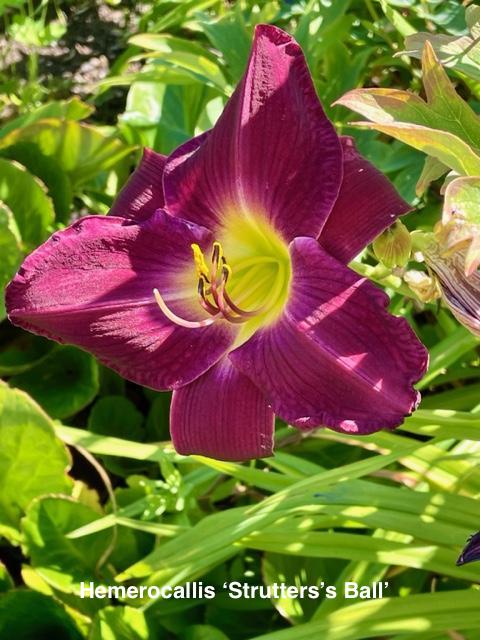- In the Garden
- >
- Gardens
- >
- Gardens A-D
- >
- Bentall Garden
- >
- Hemerocallis ‘Strutters’s Ball’ & ‘Purple de Oro’
Hemerocallis ‘Strutters’s Ball’ & ‘Purple de Oro’
Common name: Daylily
Daylily (Hemerocallis) is a genus of about 15 species native to Asia and Central Europe. The common name ‘daylily’ can fool you. These plants are not lilies. They are herbaceous perennials. Most are fibrous rooted, but some are tuberous rooted. The day part of the common name is good though. The flower just lasts a day. Another bud will open and replace it. And this goes on and on for several months. Daylilies sold today are almost entirely hybrids. More than 60,000 cultivars have been registered with the American Hemerocallis Society.
In the 1960s, breeders were trying to find new methods to increase daylily colour range, make larger more ruffled flowers, and lengthen the blooming period. Colchicine, a highly poisonous chemical alkaloid derived from the autumn crocus (Colchicum), was artificially introduced into the breeding. It altered the chromosome count in the daylily from 22 chromosomes (diploid) to 44 chromosomes (tetraploid). More about this.
Hemerocallis ‘Strutters’s Ball’ is a tetraploid. Large cranberry-purple flowers with ruffles and yellow throats on sturdy flower stalks (scapes). Even grows well in restricted urban spaces with poor soil and pollution. Overdosed on chromosomes, It struts everywhere.
Hemerocallis ‘Purple de Oro’ is a diploid. Produces small purple flowers with ruffled edges and golden throats. Compact, vigorous, and blooms throughout the summer. ‘Purple Oro’ was bred by Degroot in 2000.
Daylilies are often called the perfect perennial because of their showy flowers, drought tolerance, heat stress immunity, ability to grow in most hardiness zones, and low care requirements. But there is more - daylilies attract butterflies and hummingbirds. They are toxic to cats and even rabbits tend to avoid them. Unfortunately, there is one species daylily that has become invasive, the tawny daylily (Hemerocallis fulva). We see it in gardens, along roads, in fields, and cemeteries. It is native to Asia and has begun displacing native plants.
The pictures of H. ‘Strutter’s Ball’ in bed 37 (Bentall Garden) and H. ‘Purple de Oro’ in bed 35D (Ornamental Grass Garden) were taken in July.
Text and photos by Hughie Jones








